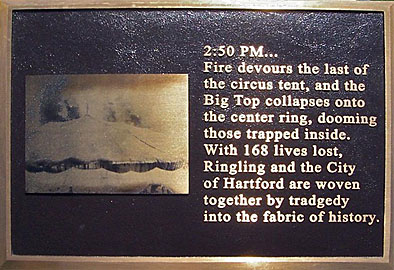Proofreading for Spelling
In 1988 the University of Wisconsin awarded thousands of diplomas with the glaring spelling error “Wisconson” on every one of them. Amazingly, six months passed before anyone noticed this blunder. A university official at the time insisted that the diplomas had been proofread, but only to check students’ names and degree subjects—not any of the “standard information” like the name of the state.
Ouch! The moral of that story is to proofread everything because errors can happen anywhere in a written document. People have even misspelled their own names, obviously not because they didn’t know the correct spelling, but because it never occurred to them to proofread every word they wrote.
Writing done on a computer or paper can be easily corrected, but that’s not the case if the writing is chiseled in stone or cast in metal like the example below that appears on an established monument. Can you spot the spelling error? When written words are involved, no person or document is safe from mistakes.

Source: Plaque, Hartford Circus Fire Memorial, Flickr
If you chose "tradgedy," you are correct--the correct spelling should be "tragedy." Basically, there are two kinds of spelling errors: those that are easy to find and fix and those that are not so easy to find.
It’s easier, for example, to find misspellings that create “words” that aren’t really words (teh instead of the, begining instead of beginning). You might be able to catch these typos or mistakes, either on your own or with an electronic spell-checker. For these errors, you can use a computer and the spell-checker.
The second type of error, however, threatens your writing more, because the misspelled word is actually a word but not the right word (witch for which, bore for boar). Many errors of this kind are caused by homophones, which are closely related to homonyms. The bad news is that spell-checkers will miss most spelling errors of this kind in the text. In other words, the computer misses the errors that people have a hard time finding. So if you depend on your spell-checker to take care of everything, think again. Because electronic gadgets can’t proofread accurately, you’re going to have to do it yourself. Still not convinced? Read the following stanzas of this poem.
Candidate for a Pullet Surprise
(often called “An Owed to the Spelling Checker”)
by Mark Eckman and Jerrold H. Zar
I have a spelling checker.
It came with my PC.
It plane lee marks four my revue
Miss steaks aye can knot sea.
Eye ran this poem threw it,
Your sure reel glad two no.
Its vary polished in it’s weigh,
My checker tolled me sew.
A checker is a bless sing,
It freeze yew lodes of thyme.
It helps me right awl stiles two reed,
And aides me when aye rime.
Each frays come posed up on my screen
Eye trussed to bee a joule
The checker poured o’er every word
To cheque sum spelling rule. . . .
Imagine you’re left to proofread on your own, without access to a computer or spell-checker. You can only be efficient as a spelling proofreader if you keep in mind some major spelling rules. Notice that with almost all of the following rules, there are multiple exceptions that make you want to tear your hair out. If it makes you feel any better, those exceptions make writers, grammarians, and English teachers everywhere want to tear their hair out, too. Causing additional hair-pulling, British and American spellings of many words differ even though English is the common language. With all those things in mind, let’s take a quick look at some of the wild and crazy American English spelling rules you should know in order to be a better proofreader.
- IE/EI
Use I before E, except after C or the long sound of A, like neighbor and weigh.
i before e believe friend siege chief niece ei after c receive ceiling receipt conceive deceit ei sounds like long a eight vein sleigh freight weight
Some exceptions: either, neither, leisure, weird, seize, seizure, foreign, forfeit, height, protein
- Prefixes
When adding a prefix, the spelling of the base word remains the same. (Ironically, one of the most misspelled words is misspell. The prefix mis- is simply added to spell, so the word has two s’s, not one.)
This rule doesn’t have any exceptions, but a few prefixes can be followed by a hyphen (for example, self-, all-, ex-).
- Keeping or dropping a silent “e” at the end of a word
(1) Drop the final -e when adding an ending that begins with a vowel (surprising, guidance).
(2) Keep the silent -e when adding an ending that begins with a consonant (careful, accurately).
Some exceptions to (1): dyeing (so it’s not confused with dying); mileage (so it’s not mispronounced incorrectly as "mill"-age); noticeable, courageous (so the words will retain the soft rather than the hard sound of -c or -g)
Some exceptions to (2): truly (not truely) and argument (not arguement) in which the silent -e is preceded by another vowel
- Keeping or dropping a “y” at the end of a word
(1) With words ending in y preceded by a consonant, change the -y to -i before any suffix not beginning with -i (beauty becomes beautify, worry becomes worried).
(2) Keep the -y when it follows a vowel or when the suffix starts with -i (pray becomes prayer, study becomes studying).
- Plurals
The regular way to form the plural of a noun is to add -s to the singular form (boys, books, chairs).
Some exceptions: leaf, leaves; life, lives; child, children; mouse, mice
—Singular nouns ending in -s, -sh, -ch, or -x form the plural by adding -es (dresses, bushes,
beaches, boxes).
—Nouns ending in -o preceded by a vowel usually form the plural by adding -s (radios, rodeos).
—Nouns ending in -o preceded by a consonant usually form the plural by adding -es (heroes, potatoes).
Some exceptions: solo, solos; soprano, sopranos; piano, pianos
- Using the right word
Yikes! You know there are lots of homophones, and you know that you sometimes use the wrong ones. Since a spell-checker is useless for this problem, you need to recognize and know the meaning of as many homophones as possible. Click here to visit a site that has an alphabetized list of hundreds of homophones. After you click on a letter of the alphabet (scroll to see the list), you can click on any word to find out its meaning.
Strategies to proofread for spelling
Here are some strategies you can use to proofread spelling
Source: Uptown & Queeens, Squid Ink, Flickr
- Keep an alphabetized list of the words that trip you up and use it as a reference for proofreading. Most people misspell the same words over and over, so the most helpful strategy for catching spelling errors is to know your own error pattern—the words that always give you trouble.
- Turn off the spell-checker and only switch it on after you have finished writing. That will enable you to see which spelling mistakes you repeat in your writing.
- Read your paper out loud. This forces you to read each word individually and increases the odds that you will find misspellings, especially typos and homophones.
- Read each word individually, from right to left, starting at the end of your paper. Yes, read backwards, word by word. Because content, punctuation, and grammar won’t make any sense, your focus will be entirely on the spelling of individual words.
- Keep a dictionary handy and use it to confirm any word you’re unsure about. This is a low-tech, tried-and-true strategy. A computer dictionary is certainly helpful, but it likely falls short of a good college-edition dictionary in paper or CD form. If your spell-checker suggests a bizarre correction for one of your words, don’t automatically accept it; instead, use a dictionary to be sure.

Source: Banana LOL, 92wardsenatorfe, Flickr
Here’s one last thought about spelling. In the world of texting, blogging, e-mailing, and social networking, spelling shortcuts have become the norm. Although “C U 4 lunch 2moro” might be understandable as a quick electronic message to your friend, those condensed versions of words won’t make sense in most other writing situations. Certainly, textese works for casual exchanges; however, appropriate language is essential for more formal writing such as letters, applications, academic papers, and business correspondence. Consider the subject, occasion, audience, and purpose of what you are writing. When you take all those factors into consideration, it’s easy to see that both textese and conventional spelling have their places in modern communication.
To check your general spelling knowledge and to gauge your ability to choose correct homophones and differentiate among commonly confused words, take the interactive quiz here.